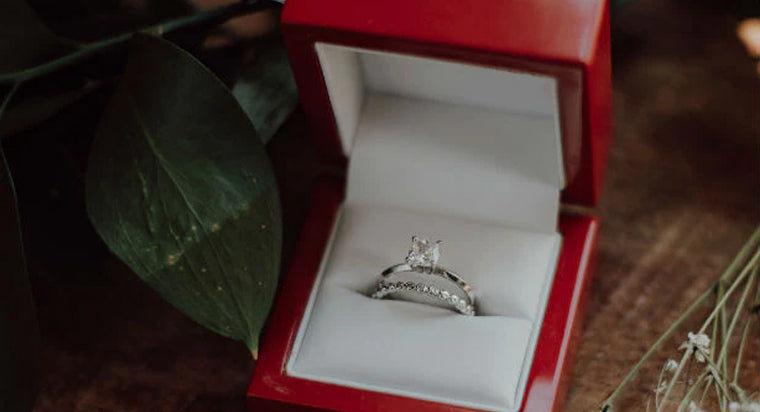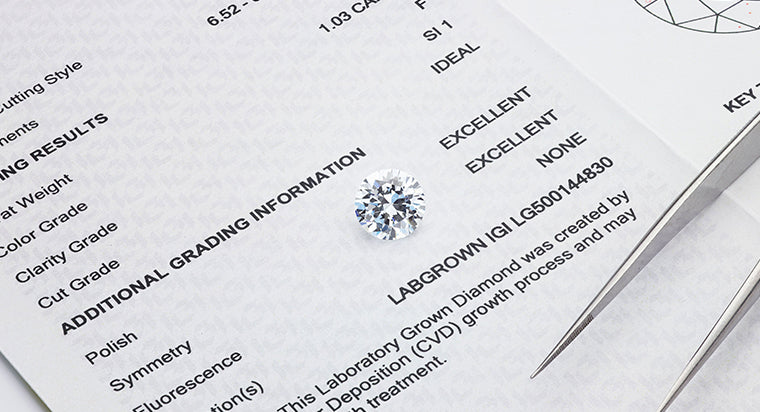10 Surprising Facts about Lab Diamonds

If you want to learn more about lab diamonds and what they’re all about, you’ve come to the right place. Lab diamonds are steadily working their way into becoming an excellent alternative to earth-mined diamonds. They already are an increasingly popular alternative that hundreds of thousands of people opt for each day.
Their popularity continues to grow each year, and lab diamonds are used in every type of fine jewelry you can think of - including engagement rings.
If you’re interested in lab diamonds but not fully aware of their details, we’ve got 10 facts for you that will certainly leave you surprised. Let’s get into them!
TABLE OF CONTENTS
1. Lab diamonds are the same as earth-mined diamonds
Lab Diamonds are optically, chemically and physically the same as earth-mined diamonds. They are just as durable, and thermally the same as well. The only difference between them is the way that they are produced - in a lab rather than pulled from the earth.
2. There are two methods to create lab diamonds
There are two different ways to create lab diamonds: CVD and HPHT. CVD stands for chemical vapour deposition, and HPHT stands for high pressure high temperature. Both methods produce the same results - a lab diamond identical to earth-mined diamonds.
During the CVD creation, a tiny slice of a diamond is put in a chamber and then exposed to gas full of carbon. The temperature is exceptionally high. It takes only a few weeks for the carbon ions and particles to stick to that minuscule piece of diamond, creating a fully crystallized formed diamond.
The CVD process is slightly better than producing lab diamonds through HPHT. This is largely due to the fact that the HPHT method uses metal, which does sometimes enter the diamond and can cause inclusions. However, any potential traces of metal won’t be visible to the naked eye.
3. Professional jewelers cannot tell the difference
Both professional jewelers and gemologists are unable to tell the difference between a lab-created diamond and a natural one just by looking at it with the naked eye. This means that any other person looking at it wouldn’t be able to tell either. That’s how similar they are.
4. Lab diamonds last forever
If you’re looking for a legacy that you can pass down, a lab diamond or any piece of lab diamond jewelry is the perfect option. Natural stones, especially ones that have been cut, can have unpredictable futures, and murky pasts. Sometimes completely untraceable. However, lab diamonds can easily be passed down for generations, down to the details of when it was first created.
5. Lab Diamonds will pass a diamond tester
When it comes to passing a diamond tester, both lab diamonds and natural diamonds will produce results that are very close to each other. There is always space for results to vary though, due to the composition of nitrogen. Since the chemical and physical characteristics of lab diamonds are the same though, they will pass a diamond tester.
6. Lab diamond is not the same as cubic zirconia
A lab diamond is a real diamond, they are not synthetic. Cubic zirconias, on the other hand, are synthetic diamonds. They can also be called artificial ones. This is because synthetic diamonds have no properties or characteristics of real diamonds, they only have the same beauty. Lab diamonds, however, have all the same carbon properties and everything else that earth-mined diamonds have.
7. Lab diamonds cost less than earth mined diamonds
Due to how they are created, lab diamonds are more affordable than earth-mined diamonds. They are often nearly 20% to 30% less, sometimes as much as 40% cheaper. This makes them an incredible option for someone who wants a larger diamond but might not be able to afford one anyways.
8. Lab diamonds are graded as per the 4cs
Just like earth-mined diamonds, lab diamonds are graded as per the 4cs. The 4cs stand for color, cut, clarity and carat. Each of these has specific characteristics that determine the value and worth of the diamonds.
9. Lab diamonds can be found in an extensive range of cuts, sizes, color and shapes
Just like earth-mined diamonds, lab diamonds can be found in a wide variety of cuts, sizes, colors and shapes. They can be made into every single cut and size you’d like.
10. Lab diamonds are 100% conflict-free.
One more benefit of lab diamonds is that they are 100% conflict-free. They are always created in a sustained, controlled environment where no humans can get exploited. They are also more sustainable for the earth because they are created in a much smaller space, instead of having to mine miles and miles of land. After the land is mined, it can be decades before that land is usable again for flora or fauna.
Parting Note
Overall, lab diamonds deserve just as much attention as earth-mined diamonds do. If anything, they even come with a few more benefits. They are always of the exact same quality, yet at a more affordable price. They are still real diamonds that can be used in every type of jewelry that earth-mined diamonds are used in.
FAQs
Do lab diamonds sparkle the same way as natural diamonds?
Yes, lab diamonds sparkle the exact same way as natural diamonds do.
Is it possible to spot the difference between natural and lab diamonds?
With the naked eye, it is not possible to tell the difference between natural and lab diamonds. Everyone professional gemologists and jewelers are unable to tell the difference.
Are lab diamond engagement rings popular?
Yes, lab diamond engagement rings are very popular, and they have only grown in popularity in the last few years. They make for a more affordable engagement ring that is just as beautiful. You can also get a larger lab diamond for a better price, which is appealing to many.
Is lab diamond real?
Yes, lab diamonds are real diamonds, just as earth-mined diamonds are. They cannot be considered synthetic or artificial in any way, shape or form.







